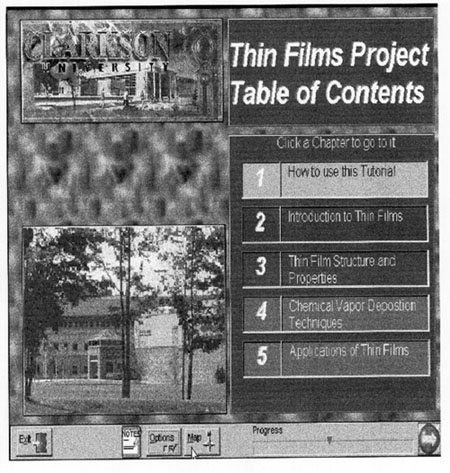
DEVELOPMENT OF MULTIMEDIA COURSE MODULES ON THIN FILM TECHNOLOGIES: CHALLENGES AND ASSESSMENT
ABSTRACT
For the last two and half years, funded by a combined research-curriculum development grant from the National Science Foundation (NSF), we have been developing and testing a set of modules in a multimedia format for use in different senior and graduate level courses dealing with various aspects of thin film technologies. The objective of the project is the presentation, evaluation and dissemination of the conceptual fundamentals underlying thin film technologies, utilizing menu-driven, easily accessible, self-contained, and interactive learning modules delivered in a CD-ROM format. Asymmetrix Corporation's Toolbook was chosen as the authoring package for creating the learning modules. Currently, along with the PIs, several graduate and undergraduate students are combining their expertise in programming Windows, Toolbook, AutoCad, 3-D studio, Real 3d, 3DF/X, Visual Basic, Visual C++, Fortran and Digital Video Producer to integrate the multimedia project tasks into different learning modules.
In this paper, after providing an outline of the current status of the project, some of the multiple design challenges faced by our team in combining the various multimedia components into a coherent entity will be described. Several trade-offs had to be made in the choice of the processor platforms and between scientifically accurate animations, computational speed, memory and disk storage space, and realistic video and animation displays. The methodology of our assessment and its results will also be discussed.
INTRODUCTION
Work on our NSF-supported curriculum-research project began in Jan 1995 with the objective of developing a modular multimedia learning tool for teaching thin film technologies to senior undergraduate and graduate students in different engineering disciplines. While work is still continuing on this project, several modules have already been created [1-3] and the functionality of some of them as learning tools has been tested with a randomly chosen group of students both in and outside the class room. Several features of these modules will be illustrated and described in this paper. In addition, we will also discuss some of the multiple design challenges faced by our team- the PI's and several undergraduate and graduate students-in creating and combining the various multimedia components into a coherent entity. Several trade-offs had to be made in the choice of the processor platforms and between scientific accuracy of the animations, computational speed, memory and disk storage space, and realism with respect to video and animation displays. The methodology of our assessment and the results will also be discussed. Some of the results of this assessment have been accepted for publication in the Journal of Educational Multimedia and Hypermedia [4].
DESCRIPTION OF THE LEARNING MODULES
The thin films project has been divided into several self-contained modules, to be supplied in the form of several CD-ROMs. Each module has been designed so that, if needed, it can be used independently in different courses in a class room context or by individual users with varied backgrounds. Each module, in many ways, offers the user far more than a textbook or a chapter in a textbook. For example, still pictures are replaced by realistic animations and video and audio overlays along with simulations. Interactive problems that can motivate the user to explore, in a visually appealing fashion, the different scenarios that result from the simultaneous variation of multiple sets of parameters in a given problem supplement the learning process.
The modules consist of menu-driven, hypertext-connected, nested and multilayered templates comprising of appropriate text, graphics - both animation and video and audio segments, with global searching and help and note taking capabilities. Press of a mouse button on "hot words" allows access to the underlying multilayered, hidden hypertext and graphics, facilitating a more detailed investigation of the topics on command by the user. This approach permits the student or any other user to explore the different topics in any desired nonlinear fashion without loss of continuity. Appropriate icons available on the screen ease navigation across the pages. These features enable the user to experience a virtual, but realistic, learning environment especially suited to the study of intricate and complex technical problems, be they at the molecular or at the macroscopic level, associated with various thin film technologies. We believe that these are the essential pedagogical features that will characterize the more successful multimedia learning tools. Several example pages from one of the thin film modules are shown in figures 1-4. An example animation sequence of the molecular collisions that lead to the deposition of thin films of silicon are shown later.
DESIGN CONSIDERATIONS AND CHALLENGES
Asymmetrix Corporation's Toolbook 3.0 was originally chosen as the authoring package for creating the modules and later replaced by the upgraded version 4.0. In spite of some limitations, it proved to be a viable and dynamic choice for this project. Toolbook allows the integration of animations, movies, hypertext, hyperlinks, graphics, notepads, problem solvers, etc. with relative ease. Currently, along with the PIs, several graduate and undergraduate students are combining their expertise in programming Windows, Toolbook, AutoCad, 3-D studio, Real 3d, 3DF/X, Visual Basic, Visual C++, Fortran and Digital Video Producer to integrate the multimedia project tasks into different learning modules.

Figure 1. Table of Contents up
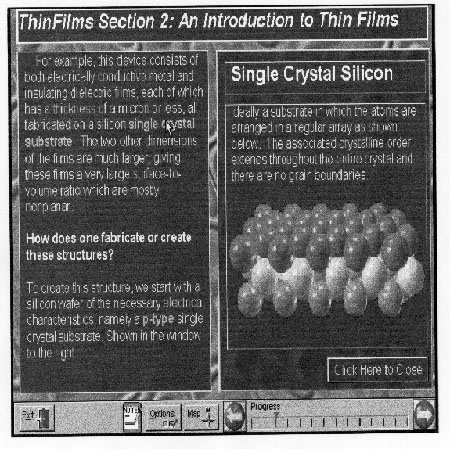
Figure 2. Typical Page Layout up
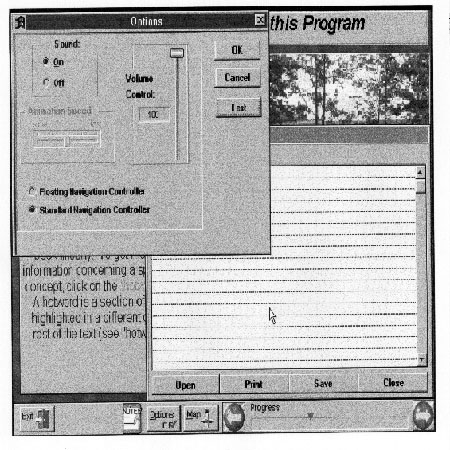
Figure 3. Help and Tools up
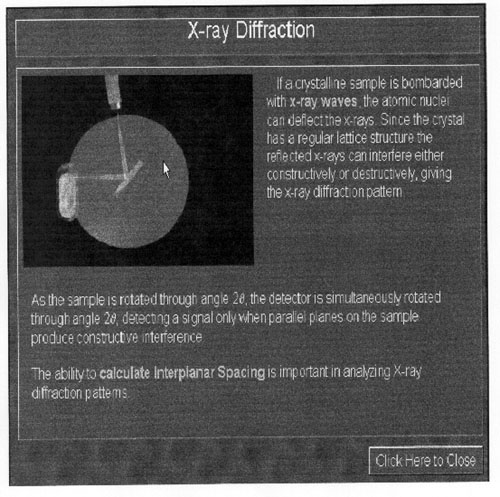
Figure 4. Full Screen Graphics and Hotwords up
As to be expected, there were many conceptual as well as hardware and software challenges that had to be overcome. They are too numerous to describe here in their entirety. A selected few are discussed below. These were in addition to those associated with managing a large group of individuals to function as a unified, coherent and responsive team with a single purpose and goal.
Some of the conceptual challenges arose from the need to balance the conflicting needs of scientific accuracy with ease of computation and visualization necessary for effective instruction while creating many of the molecular level animations and simulations. For example, accurate simulation of molecular and atomic collisions in the gas phase and nucleation, diffusion and film formation at the substrate surface requires elaborate and complex molecular dynamic or Monte-Carlo trajectory calculations. To model a system consisting of even a handful atoms and molecules requires abstract physical insight and enormous computational power and speed and could form a thesis topic by itself In any case, it is very likely that the results, by their sheer complexity, will overwhelm the user, creating confusion rather than providing insight. Given the inherent complexity of these thin film processing systems, several trade-offs had to be made in the design process when representing these molecular processes so that the ultimate instructional objective is not compromised. Consequently, the animations were created by programming each collision object by object, keeping track of the fragments using false colors, while keeping all of them in constant motion across the filed of view. This was done frame by frame, illuminating the objects with proper lighting and with cameras at convenient locations, using the capabilities of Autodesk's 3Dstudio. Some of the results are shown as still pictures in figures 5 and 6.
The hardware problems arose from the availability of increasingly more powerful PCS with improved video, sound and graphics capability as we moved forward with the project. For example, the first desktop PC bought specifically for this project was, what then was the most advanced, a Pentium 90 with a 4X CD-ROM while the latest unit is a 200 MHZ dual Pentium Pro with a 1 2X CD-ROM. While this provided a considerable reduction in the time required for rendering the animations described above, it caused several unexpected delays. For example, an initial graphics screen resolution of 640x480 pixels was chosen as the minimum for video output, so that no user would be constrained by their own system's resolution capability. However, the larger resolution of 800x600 pixels quickly became the standard, forcing us to rerender all video and graphic segments with the new standard to avoid viewing postage stamp images on the monitor screen.
We also discovered that software and hardware were not always compatible across our systems, especially when users started manipulating setups to match their personal preferences. We now have a moderately secure NT server feeding each of the WIN95 user systems. This has permitted a level of protection of the software and specialization of the individual user systems such that working versions of the product can be maintained up to date. Several additional software challenges arose in spite of the rapidly improving capability of the hardware. For example, while the upgraded Toolbook 4.0 is quite functional, the initial documentation was sparse and incomplete. Notepads, interactive problems and incorporation of certain types of graphics was not feasible. Technical support was costly and often unavailable. Even the newer version 4.0 does not provide a dedicated equation editor. All equations have to be created in Word or WordPerfect, output as graphics files, transferred to a transparent background in a paint program and then inserted in Toolbook as a graphics object. This is proving to be a significant limitation.
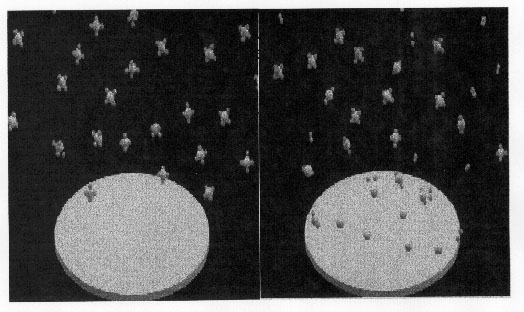
Figures 5 and 6. Animation sequence for silicon deposition from silane up
Many of the other design challenges faced by our team of developers arose from the multi disciplinary skills that were necessary for a successful transformation of the complex technical ideas into appealing visual and graphic images. For example, while we as PI's have extensive knowledge of all the concepts of thin film technologies, we are neither software experts nor proficient software designers. Familiarity with a programming language like Fortran or a symbolic language like Maple was of little use for creating animations or integrating video, audio and text segments into a coherent, usable, and meaningful entity. It was essential to learn to use authoring programs like Toolbook, animation programs like AutoCad and 3-D Studio. Fortunately, many of the current generation of engineering and computer science undergraduates seem to have the temperament necessary to work with such packages and become skilled software programmers and developers. While we were able to attract several such students to work on the thin films project, almost all them, not surprisingly, lacked even rudimentary exposure to the challenging scientific and technical concepts associated with the thin films technologies. It is as though these two fields are mutually exclusive. Fortunately, they proved not to be incompatible, and, with enough time and patience, it was possible to convey to the students the sense of the conceptual framework that we wanted to implement. Also, it has been an organizational challenge to replace graduating seniors and graduate students every year and educate their replacements without losing momentum on the project.
Ironically, solving the student-related problems turned out to be less challenging than the complementary task of educating ourselves with the necessary software programming skills. Luckily, and in a way, the need for us to acquire the necessary software skills was partly mitigated by the talent and dedication of the student members of our team. Their success in quickly creating an excellent user-friendly interface, with all the complex details of the programs hidden from the user, allowed us to concentrate on the conceptual challenges.
USABILITY ASSESSMENT AND RESULTS
Our assessment methodology and the results of the assessment were described in some detail already [1,4] and will be described only briefly here. The recent trend in software and content development has been based on iterative design. Iterative design incorporates frequent evaluations early in the design cycle by a sample group of users, followed by appropriate revisions to enhance overall usability. Assessment of the thin film multimedia courseware was performed in this context.
Students in the course ES260, "Introduction to Materials Science," were invited to explore a segment of the thin film module made available to them on a campus LAN . They were asked to describe their impressions of the software's ease of use and effectiveness and to make specific suggestions for improvement. Students' initial reactions to the software in the context of "usability" were summarized in the paper cited above. Usability studies typically attend to four elements: the user, the task or job, the context, and the computer system. The exploratory usability testing collected and synthesized information about the needs and capabilities of engineering students using the packaged material to learn the course content better.
Student inertia initially resulted in a disappointingly low response. However, inclusion of the contents of the introductory modules into an extra credit assignment was very effective in encouraging the students to explore the software. Eventually approximately 45 students, which is about 25% of the total group, sent detailed comments and suggestions to the authors by E-mail. The student response was largely enthusiastic, with many students suggesting that the experience increased their attention span and interest level. This suggests that the software is quite usable by the criteria of motivational utility, particularly in comparison to the course text, which was labeled as being ineffective by several students. One strongly perceived benefit was an increase in the ability to visualize complex three-dimensional aspects of different materials, such as the identification of crystal structures and crystallographic planes and directions. The related sections in the module contained many static graphical images and animations, which the students found to be particularly helpful in clarifying different aspects of x-ray diffraction.
Inclusion of problems was also perceived by the students as being especially helpful. Indeed, several asked for more sample problems. In the context of an engineering course, the utility of the software for developing problem solving skills is very beneficial to improved usability through task performance and can not be overemphasized. There were also many favorable comments on the effectiveness of hot words and hypertext linkages in highlighting key definitions and the associated descriptive animations. A couple of students were confused about the presence of hot words, reinforcing the connection between familiarity with hypermedia and usability and demonstrating the importance of providing detailed instructions for less computer-literate users. The note pad and search facility provided by Toolbook and the calculator from Windows were cited by a large number of students as features which made the software easier to use. Surprisingly, the interactivity and the nonlinearity of navigation were cited by very few students in either a negative or positive way, possibly because they took it for granted.
The students also perceived several shortcomings in the software. A major one, on which we as developers had initially little control, was the slowness of the local area network (LAN) on which the software was made available. This is an important issue given the voluminous traffic on the Internet and the immense size of the files that must be accessed in multimedia presentation. Another suggestion was to include a glossary at the end of the text. One student suggested that more real-life engineering examples would be more motivational.
Future plans included more detailed assessment of the prototype which has been developed. Kolb Learning Style Inventory(LSI) tests from McBer and Company will be performed to assess the students learning style. This will be correlated with the assessment of individual students so that the criteria for the acceptance and performance of the prototype can be judged better.
ACKNOWLEDGMENTS
The work described here has been supported by NSF curriculum-research grant EEC- 9420571 to Clarkson University.
REFERENCES
1. I.I. Suni, S.M. Ross, D.H. Rasmussen, and S.V. Babu, Proceedings of the ASEE-NSF symposium, Washington D.C., June 96.
2. K. D. Tillstra, M.S. Thesis, Clarkson University, April 96.
3. S. Patibandla, M.S. Thesis, Clarkson University, April 97.
4. I. I. Suni and S.M. Ross, Journal of Educational Multimedia and Hypermedia, Accepted for Publication, 1997.